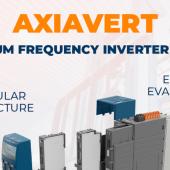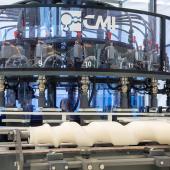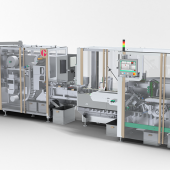Make way for the packaging of the senses
During an encounter that was held at the Ferrari Museum, Maranello, Sun Chemical presented five innovative types of products capable of making packaging “unique”. A host of special effects, on a whole range of substrates and with a whole line of different print technologies, also for food grade applications.
They wanted to amaze us with special effects and ultra-lively colors… and they managed to do so. Quoting and old TV ad, this is truly what I felt at the end of the day, after having taken part in the event “Rosso Sun Chemical” at the Ferrari Museum, Maranello. Prestigious venue, rigorously clad in Ferrari red, perfectly in line with the subject of the event - luxury packaging - with a focus on the elements indispensable to the world of packaging, to make products stand out on the shelves and draw the customers’ attention.
Indeed the ink multinational has made us get used to out-of-the-box combinations: where they featured in Milan’s “Cooking with you” at inKitchen (truly in the kitchen!) presenting in 2013 four lines of hi-tech, food grade barrier coatings, and at last year’s, “Color, Art and Fragrance” at the Ca’ del Bosco wine cellars, Erbusco, accompanied by Spumante, featuring Pantone Line and SunColor Box (a combination that, at the end of the day, made its mark on many).
A tradition that bears witness to their attention - total and unwavering - for the world of print on packaging and, in particular, to its protagonists, people.
Because, first and foremost, these events are presentations that allow those taking part to compare notes on technical matters, but with fun and convivial moments, they actually allow people to get to know each other, as the group CEO Fabio Deflorian strived to state.
The effect it has on you
The Ferrari Museum was the stage for innovation, technology, efficiency, design, quality, experience and… color. All aspects that, in a very different way, are part of the experience of the people who operate in the packaging world, aboveall when the objective is that of creating packaging with a high added value.
And hence we have the Sun Chemical: SunInspire®, the tool that helps brand owners, designers, printers to get their bearings in the complex world of sensorial packaging where, alongside absolutely essential colors and graphics, other effects come into play that involve senses other than that of sight.
But what is an effect? This was explained to us by Paolo Caiani, technical director of SF + UV screen, and Egidio Scotini, technical director of liquid inks, knowledgeable on the subject, but by now (after an extensive training I suspect) consummate showmen.
An effect is the result of three equally important factors: the print technology used (offset, digital, gravure, flexo, screenprint), the materials (inks, lacquers and varnishes, substrates) and knowhow (the way in which the printer pinpoints the process that is optimum to achieve the desired results).
Starting from this premise the Sun Chemical “technicians” illustrated the most important examples of each of the 5 groups of the SuniInspire collection.
It was a detailed presentation, meticulously prepared with an extensive use of videos, from the opening one showing a drab, colorless supermarket, to that which poetically associated the groups of products with different sporting activities. And since it really was a matter of special effects, numerous print proofs for close-up examination and handling were in support of the images projected on the screen.
Moral of the tale: you don’t improvise special effects. They have to be the result of a shrewd and painstaking design, as well as backed up by the support of an experienced, competent supplier.
Because otherwise, what Paul Valéry wrote might also turn true for a printer…
«It’s easy to define the beautiful: it is what drives you to despair».
RossoSun
60 people covering flexible packaging converters and paper industry reps. took part at the Sun Chemical event.
All were interested in sensorial packaging, but also bent on making a good show of themselves in the “physical” trials that added substance to the event.
Not wishing to be outdone, the organizers pitched in, all the same not with the greatest of results (perhaps held back by their duty as hosts).

I have seen what you mortals could not even imagine: composed managers crammed into semiprofessional racing simulators with their eyes screwed up by the effort of keeping a Formula 1 racer on the road and trying to be among the best (all the trials were timed).
And groups of extremely serious professionals who scurried, imitating mechanics in the paddock during a pit stop, trying to change the tyres of a “replica” in the shortest time possible, jeopardising clothing and joints (I heard a composite gentleman murmur “when I give the sign, let all hell break loose”, as if he were Russell Crowe in the Gladiator).

The fun was there for all, the same as the chance to enjoy being at the home of the best-known brand the world over: Ferrari.
Then there was the ironic lesson on the company’s marketing philosophy (in a nutshell, even if you have 200 thousand euros to spend, you will still have to wait a year for your car).
The visit to the works, the polite account during the coach trip around the factory buildings (rigorously forbidden to get off!).
And the guided tour at the end of the day around the Museum, at that hour closed to the public, among rare vintage cars of outstanding beauty, such as the 250 GTO, that make you really “feel” what excellence is all about.

The SunInspire collection
Here follows a detailed description of the products presented, with characteristics and destinations of use. There is something for everyone.

METALLICS
“Mirror” effect silvers. Printing very high brilliance silver, excellent cover, but most importantly, maximum light refraction. Effect obtained using pigments produced in a vacuum process that guarantees the mirror effect surface.
• Printing processes: best effects with solvent based flexo and rotogravure, serigraphy; reduced mirror effect with water-based, UV flexo, UV offset and conventional offset.
• Supports: best results with internal printing on film; external print (film/paper) requires the use of a protective OPV.
• Color range: aluminium with various silver tones.
• Food packaging: yes.
• Applications: various packaging for food and beverage, cosmetics, gift pouches...
Low migration golds and silvers. Brilliant metallic inks for sensitive packaging such as for food and tobacco. Sun Chemical exclusive, they are low odour bicomponent offset inks.
• Printing processes: conventional offset sheet, UV flexo and specific liquid inks (flexo/roto).
• Supports: paper/carton, film.
• Color range: golds and silver, metallized tones.
• Food packaging: yes.
• Applications: food and tobacco packaging.
UV flexo silver with relief varnish. High brilliance in combination with relief varnishes (tactile effect). Example of label with different effects: moreover, the red contains a security pigment that can be detected using a special infrared device.
TACTILE
Relief Effect. Relief effect lacquer that creates a 3D structure perceivable to the touch.
• Printing processes: water- or solvent-based primer and UV relief varnish printed in rotogravure or flexo (N.b. nitrogen inerted lamps must be used); UV silkscreened varnish.
• Supports: paper/carton, film.
• Color range: special effect pigments can be incorporated into the lacquer.
• Food packaging: UV yes, serigraphy no.
• Applications: tobacco (UV rotogravure).
Texture Effect. UV varnishes with “structured” effect for a texture obtained by applying a spot of low surface tension matt varnish, followed by a specific full bottom flexo varnish.
The flexo varnish does not extend to areas where the lithographic varnish is applied, but tends to retreat, forming micro-dots that, once dry, create a special tactile effect.

Different varnish types, thicknesses applied and machine conditions can interact to create different levels of reticulation, with effects that range from simple glossy/matt to very large grain.
• Printing processes: 1st printing unit: UV flexo or lithographic varnish (conventional, hybrid, UV); 2nd printing unit: UV flexo or WB varnish (only on conventional lithographic varnish).
• Supports: paper/carton, film.
• Color range: transparent glossy/matt, compatible with metallic and pearlescent effects using UV flexo varnish.
• Food packaging: limited.
• Applications: various.
Soft Touch. Matt lacquers for altering the touch and feel of paper and carton.
• Printing processes: water and solvent based rotogravure and flexo, serigraphy (UV and solvent based).
• Supports: mainly paper/carton, film.
• Color range: semi-transparent matt.
• Food packaging: compatible.
• Applications: various.
Paper Feel. Paper effect matt varnish, for altering the touch and feel of plastic films.
• Printing processes: solvent rotogravure and flexo.
• Supports: plastic films.
• Color range: semi-transparent, matt.
• Food packaging: compatible.
• Applications: various.
LUSTRE
Interference Blue. Natural mica based inks that, when printed over another color, show a slight chromatic variation when seen from different angles.
• Printing processes: all, but ideally using a varnishing unit (for example offset).
• Supports: all.
• Color range: specific to pigment type; interaction with underlying colors (more evident with dark colors).
• Food packaging: compatible.
• Applications: various.

Blue/green iridescent. Synthetic mica based pigment inks that show clear chromatic variation depending on angle of observation. The pigments can be used both for decorating supports and for security reasons (banknotes).
• Printing processes: all, but ideally using a varnishing unit (for example offset).
• Supports: all.
• Color range: specific to pigment type; interaction with underlying colors (more evident with dark colors).
• Food packaging: compatible.
• Applications: various.
UNIQUE
Reversible thermochromic. “Interactive” with microencapsulated coloring, that switch from color to colorless when subjected to certain temperatures.
They can be mixed with conventional organic pigments to vary the color. For example, a thermochromic blue can be mixed with a conventional yellow to makes a green that becomes yellow when above a certain temperature threshold.

• Printing processes: water based flexo and rotogravure, conventional and UV offset, serigraphy, typography.
• Supports: many, depending on printing process.
• Color range: limited, especially color-color chromatic variations.
• Applications: various.
IMPACT
Fluorescent and phosphorescent inks. By combining fluorescent pigments (both UV and visible fluorescence) and phosphorescent (“glow in the dark”) ones, tones can be achieved that are brilliant regardless of light conditions.

• Print processes: many, depending on desired combination and effect.
• Supports: all.
• Color range: limited, usually used as a single color (spot).
• Food packaging: usually not suitable.
• Applications: various packaging, publishing.
Printed Optics. Printed lenses that reveal coded images, simulating depth and motion, whose novelty lies in the technology used to achieve 3D prints: no more lenticular films but rather normal supports. Using a UV digital technique, the image and 3D effect microtag are printed on the back, and the lenses on the front, with advantages in terms of precision and effect position. Technology developed by Sun Chemical along with certain of its partners.
• Printing processes: UV inkjet, swissQprint printers and Popims 3D software
• Supports: acrylic or any rigid and transparent material (thickness 3-6 mm).
• Color range: transparent.
• Food packaging: not suitable.

















